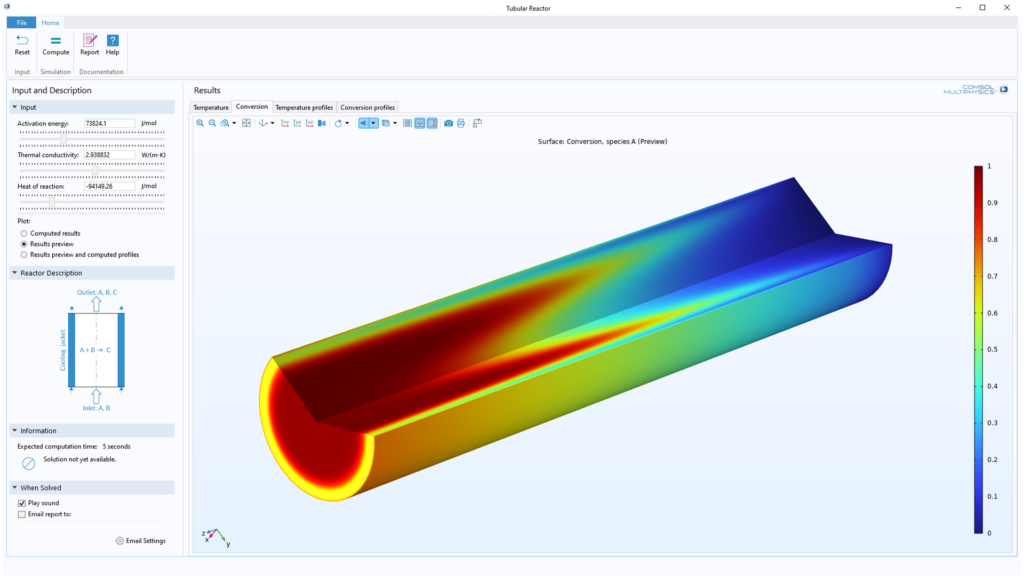In the interview COMSOL’s Ed Fontes claims that much of what is being introduced in the new 6.2 version is about, ”game-changing functionality for simulation apps and digital twins and faster solution technology.”

Hyper-fast simulations
We mentioned in the introduction that users can now increase the computational speed of their simulation apps using data-driven surrogate models, which leads to a more interactive user experience and promotes wider use of simulations within an organization. Additionally, the new surrogate model framework makes it possible to build new types of standalone simulation apps and efficient digital twins. Sharpened performance is of course also important and one of the things you expect to come with new upgraded software versions.
“That’s right,” says Fontes, “and there’s more of this in 6.2: We’re continuing to deliver faster solvers across the board. For example, the version has a new time-periodic study for nonlinear problems in electromagnetism – mainly for electric motors and transformers – which significantly reduces calculation time, turbulence models are around 40 percent faster to solve, and problems in room acoustics are almost 10 times faster in version 6.2 compared to 6.1. Our performance improvement projects continue to be among the most important. We aim to deliver solutions to multiphysics problems that provide hyper-fast simulations, and version 6.2 is a step on the way.

It can be added that in chemical engineering applications, the new version includes functionality for simulating vapor-liquid interfaces, including both condensation and evaporation processes. Furthermore, users of the structural mechanics-based products will see updated capabilities for damage and fracture modeling, along with functionality for calculating circuit board distortion and multibody dynamics analysis in electric motors.
Ease of use crucial
Fontes also generally believes that the company’s software is extremely user-friendly for its industry.
“Yes, but it still requires a certain amount of specialization, i.e. you have to learn a bit about modeling and simulation to be able to use it. It is important that we make multiphysics modeling and simulation available to more engineers and researchers so that more people can benefit from these methods. Simulation apps do help, but even modeling and simulation specialists who build models and apps need to be able to do this effectively.”
For this reason, among other things, ease of use is crucial, says COMSOL’s development chief.
“Exactly, and version 6.2 also contains a lot of improvements in user-friendliness. For example, we have new functionality for syntax help when entering mathematical expressions in text fields and for filtering the model tree, if for example you are looking for a special expression or boundary conditions. Users can also add tabs to the ”Ribbon” (main menu) where they can collect custom buttons with commands and command sequences they’ve created using methods – similar to macros that can be executed by custom buttons.”

The vision for the journey ahead
If you look at software development – what does the vision for the way forward look like?
“The vision has not changed. We need, as already mentioned, to make modeling and simulation accessible to more engineers and scientists, for our sake and theirs. This means we need to focus on ease of use and performance. It must become easier to create models and apps and these must deliver results faster.”
“This also means new products. We see demand in many areas where a small clique of innovators assemble models using our mathematical interfaces, i.e. they input their own systems of partial differential equations. These innovators are demanding new, more ”ready-made” interfaces, so that more people can benefit from modeling and so that they don’t have to do all the work themselves. New products are in our vision for the future.”
What do you see as the most important technological competitive advantage?
”The main advantage is the ease of use in the creation of multiphysics models and apps. There we are probably by far the best if you look at general functionality.”

“Almost too good to be true”
Are there any general observations among your customers that show that multiphysics simulation is growing in importance in development work?
“Yes, you definitely have a point there. More and more of our users are developing their own apps. This means that multiphysics simulations will become available to more engineers and researchers. I would venture to say that the ability to create compiled apps is also starting to become a significant competitive advantage. More users are discovering the ability to compile apps and distribute them completely freely without having to install or pay for COMSOL licenses. It’s almost been too good to be true and maybe we haven’t been very good at explaining this. At the COMSOL Conference two weeks ago, we had several large customers tell us that we have become the dominant software for them because they have been able to distribute compiled apps within the enterprise and to customers.”
Finally – how has business developed for COMSOL – do we see a continued growth trend?
“We have had four years of very good growth, we have almost doubled sales over four years. So far we match last year’s results well. If we make a good final sprint, there can be good growth this year as well.”






